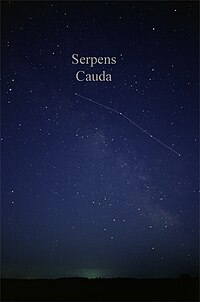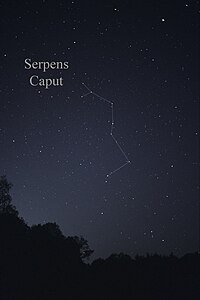Snake (constellation)
|
Constellation snake |
|
|---|---|
| Latin name | Serpens |
| Latin genitive | Serpentis |
| Abbreviation | Ser |
| Right ascension | 15 h 10 m 25 s to 18 h 58 m 18 s |
| declination | −16 ° 08 ′ 24 ″ to + 25 ° 39 ′ 51 ″ |
| surface | 636,928 deg² rank 23 |
| Completely visible | 74.2 ° N to 64.8 ° S |
| Observation time for Central Europe | summer |
| Number of stars brighter than 3 mag | 1 |
| Brightest star (size) | Unukalhai (2.63) |
| Meteor streams | |
|
Neighboring constellations ( clockwise from north ) |
|
| swell | IAU , |
The snake ( Latin Serpens ) is a constellation of the summer sky and runs near the celestial equator .
description
The snake is the only constellation in the sky that consists of two unconnected parts. The two parts are formed from elongated star chains that are interrupted by the serpent bearer (Ophiuchus). The western part of the snake is called Serpens Caput (snake, head), the eastern part is called Serpens Cauda (snake, tail). The head has a distinctive triangular shape.
Serpens Cauda is on the edge of the Milky Way . Here you can find the well-known gas nebula M 16, also called the Eagle Nebula , and the open star cluster IC 4756 .
history
The snake is one of the 48 constellations of ancient Greek astronomy , which were already described by Ptolemy .
In 1970 the Nova FH Serpentis was discovered in line.
mythology
The ancient Greeks saw a snake in the constellation, which is carried by the healer Asklepios (Latin Aesculapius) - the snake bearer. It is the same snake that winds around the staff of Aesculapius , the symbol of healing .
According to one version, Glaucus , the son of the Cretan king Minos , fell into a honey barrel and suffocated in it. The seer Polyeidus found the boy. Minos then had the seer locked up with the dead and ordered him to bring his son back to life. When a snake crept towards Polyeidos, he killed it. Immediately a second snake with herbs in its mouth came along and brought the dead conspecific to life. Polyeidos used the same remedy on Glaucoma, who actually awoke.
According to another version, Asklepios is said to have awakened the boy.
Celestial objects
Stars
| B. | F. | Names or other designations | size | Lj | Spectral class |
|---|---|---|---|---|---|
| α | 24 | Unukalhai , Unuk al Hay, Unuk, Cor Serpentis | 2.63 m | 73 | K2 III |
| η | 58 | 3.23 m | 62 | K0 III-IV | |
| μ | 32 | 3.54 m | 156 | A0 V | |
| ξ | 55 | 3.54 m | 105 | F0 IIIp | |
| β | 28 | Chow | 3.65 m | 153 | A3 V |
| ε | 37 | 3.71 m | 70 | A2 Vm | |
| γ | 41 | 3.85 m | 36 | F6 V | |
| θ 1.2 | 63 | Alya | 4.03 m | 132 | A5 V |
| κ | 35 | 4.09 m | 349 | M1 III | |
| δ 1 | 13 | 4.20 m | 210 | F0 IV | |
| ο | 56 | 4.24 m | 168 | A2 Va | |
| ν | 53 | 4.32 m | 193 | A0 / A1 V | |
| λ | 27 | 4.42 m | 38 | G0 V | |
| ι | 21st | 4.51 m | 192 | A1 V | |
| ζ | 57 | 4.62 m | 76 | F3V | |
| ρ | 38 | 4.74 m | 395 | K5 III | |
| π | 44 | 4.82 m | 177 | A3 V | |
| σ | 50 | 4.82 m | 89 | F0 V | |
| MQ | 5.06 | 81 | F8 III-IV | ||
| 36 | 5.09 | 159 | A3Vn | ||
| 10 | 5.15 | 122 | A8 IV | ||
| τ 1 | 9 | 5.16 m | 919 | M1 III | |
| R. | 5.16 | 911 | M5 IIIe - M9e | ||
| δ 2 | 5.20 | 210 | F0 IV | ||
| d | 59 | 5.20 | 479 | G0 III + A6 V | |
| ω | 34 | 5.21 m | 263 | G8 III | |
| 16 | 5.26 | 235 | K0p | ||
| 3 | 5.32 | 467 | K0 III | ||
| χ | 20th | 5.34 m | 228 | A0p Sr | |
| 6th | 5.35 | 244 | K3 III | ||
| 60 | 5.38 | 236 | K0 III | ||
| HR 6016 | 5.39 | 494 | K4 III | ||
| HR 6858 | 5.39 | 471 | K3 III | ||
| 25th | 5.39 | 408 | B8 III | ||
| HR 5924 | 5.45 | 602 | M0 III | ||
| 11 | 5.50 | 270 | K0 III |
The brightest star is α Serpentis in the snake's head. It is a 73 light-years distant, orange glowing giant star with 15 times the diameter and 35 times the luminosity of our sun .
His name Unuk is of Arabic origin and is a shortened form of "Unuk al Hay", "Neck of the Serpent". Another name is "Cor Serpentis", Latin for "heart of the snake".
Double stars
| system | Sizes | distance |
|---|---|---|
| β | 3.65 / 9.9 / 10.7 m | 31/207 ″ |
| δ | 4.2 / 5.2 / 14.7 / 15.2 m | 4/66 / 4.4 ″ |
| θ | 4.5 / 5.4 m | 22 ″ |
β Serpentis is a multiple star system , consisting of three stars that revolve around a common center of gravity. The system is 153 light years away. A telescope with an opening of 6 cm or more is required for observation .
In classical Chinese astronomy , β Serpentis was called Chow and was a symbol of the Zhou dynasty .
δ Serpentis is a quadruple star system 210 light years away. It consists of two pairs of stars. The two components A and B are sub-giants of the spectral class F0 IV with an angular distance of 4 arc seconds , which orbit each other in 3200 years. They are already visible in a small telescope with an opening of 5 cm. δ Serpentis B is also a variable star . The second system consists of the weaker components C and D, which are separated by 4.4 arc seconds.
The name Alya for the system δ Serpentis comes from the Arabic and means "fat tail", which is used to describe a certain breed of sheep .
θ Serpentis is a binary star 132 light years away. The two stars belong to the spectral class A5 and can be separated with prism binoculars .
Variable stars
| star | m | period | Type |
|---|---|---|---|
| δ Serpentis B | 4.23 ± 0.04 | 0.134 days | Delta Scuti star |
| R serpentis | 5.16 to 14.4 | 356.4 days | Mira star |
| U serpentis | 7.66 to 14.7 | 239 days | Mira star |
| W serpentis | 8.42 to 10.2 | 14.15 days | W serpentis star |
| χ Serpentis | 5.33 ± 0.03 | 1.60 days | Alpha 2 -Canum Venaticorum Star |
| CT Serpentis | 6.0 to 16.6 (p) | 4.7 hours | nova |
δ Serpentis B is a short -period pulsation - variable star . In a rhythm of only 3 hours and 13 minutes, its brightness changes by a barely noticeable 0.04 size classes.
R Serpentis is a long-period pulsation-variable star of the Mira type at a distance of 900 light years. It changes its brightness significantly over a period of 356.4 days. During the maximum brightness it can be seen with the naked eye, at the minimum you need a medium telescope. It is a reddish star belonging to the spectral class M6 III.
Messier and NGC objects
| Messier (M) | NGC | other | size | Type | Surname |
|---|---|---|---|---|---|
| M 16 | 6611 | Eagle Nebula | 6.0 m | Gas mist | |
| M 5 | 5904 | 5.7 m | Globular clusters | ||
| 6604 | 6.5 m | Open star cluster | |||
| 6605 | 6.0 m | Open star cluster | |||
| IC 4756 | 4.6 m | Open star cluster | |||
| PGC 54559 | 16.4 m | Ring galaxy | Hoag's object |
Two foggy objects are visible in the queue, which the French astronomer and comet hunter Charles Messier added to his catalog ( Messier catalog ).
M 5 is a globular cluster about 27,000 light years away. It is one of the brightest globular clusters in the northern sky. In the binoculars it appears as a misty spot. With a middle telescope it can be resolved into single stars at the edge.
M 16 is the Eagle Nebula, 7000 light years away . Images of the Hubble telescope are known , which show huge clouds of gas and dust. This region is a star formation region. A medium-sized telescope is required to observe the nebula. What is more noticeable in visual observation is the open star cluster that is embedded in the nebula. The complex fog structures only become visible in photographs that have been exposed for a longer period of time .
IC 4756 is a rather inconspicuous open star cluster 1400 light years away. In prism binoculars and smaller telescope about 50 stars are visible.
Hoag's object is a nearly circular ring galaxy about 600 million light years away.
Other objects
The quasar PDS 456 is the brightest quasar as seen from the Milky Way.
See also
Web links
Individual evidence
- ↑ a b c VSX
- ↑ PDS 456. In: Frankfurt Quasar Monetoring. Retrieved May 31, 2015 .
- ↑ Min Yun, NA Reddy, NZ Scoville, DT Frayer, EI Robson, RPJ Tilanus: Multiwavelength Observations of the Gas-rich Host Galaxy of PDS 456: A New Challenge for the ULIRG-to-QSO Transition Scenario. (pdf) Archived from the original on February 20, 2015 ; accessed on February 20, 2015 (English): "We report new K-band, radio continuum, and CO (1–0) imaging observations and 850μm photometric obser-vations of PDS 456, the most luminous QSO in the local universe (z <0.3). "


